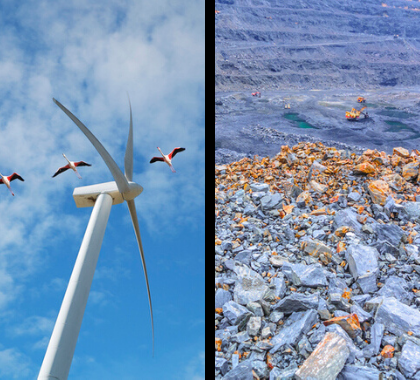“We had to destroy the village in order to save it.” The infamous Vietnam-era quotation may or may not have been uttered by an anonymous U.S. Army major. It may have been misquoted, revised, apocryphal, or invented. But it quickly morphed into an antiwar mantra that reflected attitudes of the time.
For Virginians and others forced to travel the path of “clean, green, renewable, sustainable” energy, it will redound in modern politics as “We had to destroy the environment in order to save it.”
Weeks after Gov. Ralph Northam signed Virginia’s “Clean Economy Act,” which had been rushed through a Democrat-controlled legislature on partisan lines, Dominion Energy Virginia announced it would reach “net zero” greenhouse gas emissions by 2050. To do so, the utility company will raise family, business, hospital, and school electricity bills by 3 percent every year for the next ten years, as these customers and state and local governments struggle to climb out of the financial holes created by the ongoing coronavirus lockdown.
Just as bad, renewable energy mandates and commitments from the new law and Dominion’s “integrated resource plan” will have major adverse impacts on Virginia and world environmental values. In reality, Virginia’s new “clean” economy exists only in fantasy land, and only if we ignore “clean” energy’s CO2 emissions, air and water pollution, and other environmental degradation around the world.
Dominion Energy plans to expand the state’s offshore wind, onshore solar, and battery storage capacity by some 24,000 megawatts of new “renewable” energy by 2035, and far more after that. It will retain just 9,700 MW of existing natural gas generation, and only through 2045; build no new gas-fired units; and retire 6,200 megawatts of coal-fired generation. This will reduce in-state carbon dioxide emissions but certainly won’t do so globally. The company intends to keep its four existing nuclear units operating.
To “replace” some of its abundant, reliable, affordable fossil fuel electricity, Dominion intends to build at least 31,400 megawatts of expensive, unreliable solar capacity by 2045. The company estimates that will require a land area some 25 percent larger than 250,000-acre Fairfax County, west of Washington, D.C. Dominion Energy’s new solar facilities will blanket 490 square miles (313,000 acres) of beautiful croplands, scenic areas, and habitats that now teem with wildlife.
That’s almost half the land area of Rhode Island, eight times the District of Columbia, 14 times more land than all Fairfax County parks combined, blanketed by imported solar panels. Still more land will be torn up for access roads and new transmission lines. All this is just for Dominion Energy’s solar panels.
The panels will generate electricity maybe 20-25 percent of the year, once you factor in nighttime hours, cloudy days, and times when the sun is not bright enough to generate more than a trifling amount of electricity.
Dominion and other Virginia utility companies also plan to import and install 430 monstrous 850-foot-tall bird-chopping offshore wind turbines, plus tens of thousands of half-ton battery packs to provide backup power for at least a few hours on days when the sun isn’t shining and the wind isn’t blowing. The batteries will prevent the economy from shutting down even more completely during each outage than it has during the corona lockdown. Similar policies across the United States will impact hundreds of millions of acres.
Most of these solar panels, wind turbines, and batteries—or their components, or the metals and minerals required to manufacture those components—will likely come from China or from Chinese-owned operations in Africa, Asia, and Latin America, under mining, air and water pollution, workplace safety, fair wage, child labor, mined land reclamation, manufacturing, and other laws and standards that would get U.S. and other Western companies unmasked, vilified, sued, fined, and shut down in a heartbeat.
It is those minimal-to-nonexistent laws and regulations that govern most of the companies and operations that will supply the “clean” technologies that will soon blight Virginia landscapes and serve the new, “clean” Virginia economy. As Michael Moore observes in his new film, Planet of the Humans, other states that opt for “clean” energy will face the same realities.
Thus far, no one has produced even a rough estimate of how much concrete, steel, aluminum, copper, lithium, cobalt, silica, rare earth metals, and countless other materials will be needed. All will require gigantic heavy equipment and prodigious amounts of fossil fuels to blast and haul away billions of tons of rocky overburden; extract, crush, and process tens of millions of tons of ores, using acids, toxic chemicals, and other means to refine the ores; smelt concentrates into metals; manufacture all the millions of tons of components; and haul, assemble, and install the panels, turbines, batteries, and transmission lines, setting them on top of tens of thousands of tons of concrete and rebar. All of it beyond Virginia’s borders.
No one has tallied the oil, natural gas, and coal fuel requirements for doing all this “Virginia Clean Economy” work, nor the greenhouse gases and actual pollutants that will be emitted in the process.
Nothing about this is clean, green, renewable, or sustainable. But Virginia politicians and Dominion Energy officials have said nothing about any of this, nor about which countries will host the mining and other activities, under what environmental and human rights standards.
Will Virginians ever get a full accounting? Just because all of this will happen far beyond Virginia’s borders does not mean we can ignore the global environmental impacts. Nor should we ignore the health, safety, and well-being of children and adults in those distant mines, processing plants, and factories.
This is the perfect time to observe the environmentalist creed: think globally, act locally. Will that be done?
Will Dominion and Virginia require that all these raw materials and wind, solar, and battery components be responsibly sourced? Will they require independently verified certifications that none of it involves child labor and all is produced in compliance with U.S. and Virginia laws, regulations, and ethical codes for workplace safety, fair wages, air and water pollution, wildlife preservation, cancer prevention, and mined lands reclamation? Will they tally up all the fossil fuels consumed, and pollutants emitted, in the process?
Science journalist, businessman, and parliamentarian Matt Ridley says wind turbines need some 200 times more raw materials per megawatt of power than modern combined-cycle gas turbines. It’s probably much the same for solar panels. Add in the millions of wind turbines, billions of solar panels, and billions of backup batteries that would be required under a nationwide Green New Deal, and the combined U.S. and global environmental, human health, and human rights impacts become absolutely mindboggling.
If you ignore all the land and wildlife impacts from installing the wind turbines, solar panels, batteries, and transmission lines, you could perhaps call this “clean energy” and a “clean economy” within Virginia’s borders. But not beyond those borders. This is a global issue, and the world would likely be far better off if we just built modern combined-cycle gas turbines (or nuclear power plants) to generate reliable electricity, avoiding all the monumental human and ecological impacts of pseudo-renewable energy.
When it’s time to select sites for these 490 square miles of industrial solar facilities, will Virginia, its county and local governments, its citizens, environmentalist groups, and courts apply the same rigorous standards, laws, and regulations that they demand for drilling, fracking, coal and gas power plants, pipelines, highways, timber cutting, and other projects? Will they apply the same standards for 850-foot-tall wind turbines and 100-foot-tall transmission lines as they demand for buried-out-of-sight pipelines?
Virginia’s Clean Economy Act will also plunge almost every project and jurisdiction into questions of race, poverty, and environmental justice. Dominion Energy and other utility companies will have to charge means-tested rates (even as rates climb by 3 percent per year) and exempt low-income customers from some charges. They will have to submit construction plans to “environmental justice councils,” even as the companies, councils, and politicians ignore the rampant injustices inflicted on children and parents slaving away in Chinese, African, and Latin American “clean energy” mines, processing plants, and factories.
Government officials, utility industry executives, environmentalists, and anyone else who promotes wind, solar, battery, and biofuel energy need to explain exactly how they plan to address these issues. Future town hall meetings and project approval hearings promise to be raucous, entertaining, and illuminating.
— Guest essayist Paul Driessen is a senior policy analyst for the Committee For A Constructive Tomorrow (www.CFACT.org), author of books and articles on energy, environment, climate, and human rights issues, and a policy advisor to The Heartland Institute.
SOURCES: Committee For A Constructive Tomorrow; The Spectator; Bacon’s Rebellion
IN THIS ISSUE …
GERMAN COURT BLOCKS FACEBOOK CLIMATE ARTICLE ‘FACT CHECK’ … LAB-MODIFIED ALGAE MAY HELP CORAL REEFS ADAPT … wind turbine output falls after government support ends
GERMAN COURT BLOCKS FACEBOOK CLIMATE ARTICLE ‘FACT CHECK’
Free speech and climate debate recently scored a big victory in German courts.
A post on Watts Up With That reports an appellate court in Karlsruhe, Germany found a “fact check” on Facebook of a skeptical climate change posting was not fact-based but rather was political opinion and had to be removed or Facebook would face a large fine.
In September 2019, Tichys Einblick (Tichy’s Insight), a centre-Right magazine in Germany, published an open letter to the UN Secretary-General from more than 500 scientists, researchers, and professionals in the worldwide Climate Intelligence Group (CLINTEL) stating, “There is no climate emergency.” I covered the same letter in Climate Change Weekly issue number 338.
One of Facebook’s authorized fact checkers, Correctiv, which the social media site uses to censure “non-Communist content,” labeled Tichy‘s article as “partly false.” Correctiv gave three reasons for labeling Tichy‘s article partly false: one, not all of the signatories were scientists; two, some of the points in the open letter were incorrect; and three, it ignored the German state’s conclusion dangerous climate change was in fact indisputably happening. Tichy fought back in court, suing Facebook, claiming “Correctiv‘s supposed ‘fact-check’ was merely an expression of opinion, and that Correctiv‘s special status as Facebook‘s fact-[checker] constituted unfair competition,” as described by Lord Christopher Monckton in his Watts Up With That article covering the court case.
The Karlsruhe Court of Appeals agreed, finding in this instance Facebook’s fact check was false and ordering it to be taken down. Unless the company complies, it faces a fine of up to 250,000 euros and the relevant executives up to two years’ imprisonment.
The court ruled both Tichy’s Insight and Correctiv could publish their articles on the social network but Correctiv was wrongly allowed to set itself up as having the right to check and rate Tichy‘s article, establishing a false hierarchy of truths with the ability to reduce the article’s accessibility and readership. The court also noted if users in Germany share the insufficiently Communistic Tichy’s posting, Facebook attaches Correctiv‘s commentary, together with a link so that readers can donate to Correctiv, giving it what the court considered to be a further unfair commercial advantage.
“The fundamental question for decision by the court was who should decide what is right and wrong in an open society,” said author and attorney Joachim Steinhöfel, who represented Tichy’s Insight in the case. “This case marks the beginning of the end of Facebook‘s current ‘fact-checking’ system.”
SOURCES: Watts Up With That; Climate Change Weekly
LAB-MODIFIED ALGAE MAY HELP CORAL REEFS ADAPT
Scientists working in the field of “assisted evolution” have developed an algae that may help corals adapt more quickly to warmer ocean temperatures.
Coral and algae have a symbiotic relationship, with the algae living inside corals and using their waste products to assist food photosynthesis, which in turn nourishes the coral hosting the algae. However, when the water temperature spikes higher, coral eject algae from their bodies, which results in corals turning white or bleaching, which, if severe or long-lived enough, results in coral death.
Hoping to prevent coral deaths due to warming waters, University of Melbourne coral geneticist Madeleine van Oppen and colleagues bred one common type of alga in water at 31 degrees Celsius, comparable to the high water temperatures that caused massive coral bleaching of sections of the Great Barrier Reef, for over 100 generations over four years. The Australian researchers then introduced 10 different strains of the hot-water-adapted algae into test tubes with coral larvae, with a control group of algae raised in typical 27 degrees Celsius water, in 31 degree water for a week. Coral with three strains of “hot water” algae resisted bleaching, their cell density increasing by 26 percent.
Science notes several questions remain to be answered before we can know whether the heat-evolved algae should be introduced into wild coral populations, such as how these algae will interact with adult coral polyps, how the lab-bred algae compete with wild algae out on a reef, and whether the heat adaptation would fade over time in the wild.
SOURCE: Science
WIND TURBINE OUTPUT FALLS AFTER GOVERNMENT SUPPORT ENDS
An analysis of the output from wind turbines finds the power they produce drops off sharply after ten years, coinciding with the end of the federal production tax credit for wind projects.
Researchers at the Lawrence Berkeley National Laboratory (LBNL) found the power output of newer wind turbines declines more slowly and they suffer less downtime than turbines constructed in the past. However, for newer turbines—whose construction has been driven almost entirely by lucrative federal and state tax credits—their power output declines sharply after the first decade.
LBNL showed the power generated from an average wind farm in the United States declines by about 13 percent over their first 17 years of operation, with the great majority of this decline taking place after the project’s first decade of operation, when the federal production tax credit for energy produced expires.
During the first 10 years of operation, wind turbines experienced an average power output decline of approximately 0.17 percent per year, or 1.7 percent over the decade. By the 17th year, the average turbine’s power generation had dropped by 13 percent. Thus in just seven years the average turbine’s power output declined by 11.3 percent.
Unsurprisingly, as turbines age they suffer more breakdowns and thus have increased downtime for maintenance. Beyond that, however, LBNL found while they receive the tax credit, turbine operators are incentivized to maintain the turbines and keep them online: because “the production tax credit is paid in line with a turbine’s output, operators maximize the benefit of the support before it is phased out by keeping their turbines in better condition to maintain output levels, the researchers explained,” writes Wind Power Monthly in describing the study’s findings. After the tax credit expires, operators are less attentive to maintaining the turbines in a timely fashion.
The LBNL study found terrain and turbine type also affect turbine power production. Turbines erected on flatter terrain operate with less downtime and loss of output than those constructed on steep slopes or mountaintops. The researchers attribute this to the turbines on flat locations experiencing less stress from rapidly shifting wind turbulence. The research also found direct-drive turbines with longer blades and lower power ratings, operating at slower RPMs, also suffer fewer breakdowns and downtime, and thus have less power output decline than those with shorter, faster-spinning blades using complicated gear boxes.
SOURCES: Wind Power Monthly; Wind Action
The Climate Change Weekly Newsletter has been moved to HeartlandDailyNews.com. Please check there for future updates!






